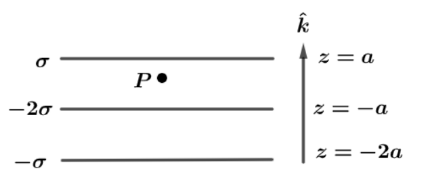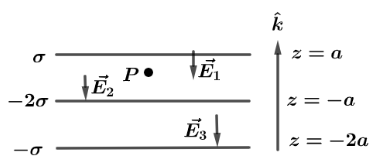
Three large parallel plates have uniform surface charge densities as shown in the figure. What is the electric field at point $P$ ?

A. $ - \dfrac{{4\sigma }}{{{ \in _0}}}\hat k$
B. $\dfrac{{4\sigma }}{{{ \in _0}}}\hat k$
C. $ - \dfrac{{2\sigma }}{{{ \in _0}}}\hat k$
D. $\dfrac{{2\sigma }}{{{ \in _0}}}\hat k$

Answer
502.2k+ views
Hint: In electrostatics, Electric field due to any point charge at a distant point is defined as the force acting on that point per unit test positive charge and Electric field is a vector quantity. In order to find the net electric field at point $P$ we will calculate the electric field due to individual plates and then add them using the addition rule of vector algebra.
Formula used:
Electric field due to a large sheet having a uniform charge density of $\sigma $ is independent of the point where it’s to be measured and it’s given by
$\vec E = \dfrac{\sigma }{{2{ \in _0}}}\hat n$
where $\hat n$ is the perpendicular direction to the plane of sheet and this direction of electric field is away from the sheet for a positive surface charge density sheet and in the direction towards the sheet if sheet having a negative surface charge density.
Complete step by step answer:
The direction of the electric field at point P due to each plate is shown in the diagram.

Since point $P$ lies below the plate of surface charge density $ + \sigma $ the, its direction is away from the sheet which is $ - \hat k$. Hence, Electric field due to the first plate is given by ${\vec E_1} = \dfrac{\sigma }{{2{ \in _0}}}( - \hat k)$. For plate second, which have a surface charge density of $ - 2\sigma $ , Point P lies above it and direction of electric field will towards the plate which is $ - \hat k$ hence, electric field due to second plate is given by
${\vec E_2} = \dfrac{{2\sigma }}{{2{ \in _0}}}( - \hat k)$
Now, for third plate Point P lies above the plate and it have a negative surface charge density of $ - \sigma $ Hence, electric field will be in direction towards the plate which is $ - \hat k$ , hence electric field for third plate is given by
${\vec E_3} = \dfrac{\sigma }{{2{ \in _0}}}( - \hat k)$
Now, Net electric field at point P can be calculated by adding the individual electric fields, since all three electric fields are in same direction of $ - \hat k$ so,
${\vec E_{net}} = {\vec E_1} + {\vec E_2} + {\vec E_3}$
On putting the values of ${\vec E_1} = \dfrac{\sigma }{{2{ \in _0}}}( - \hat k)$
${\vec E_2} = \dfrac{{2\sigma }}{{2{ \in _0}}}( - \hat k)$
$\Rightarrow {\vec E_3} = \dfrac{\sigma }{{2{ \in _0}}}( - \hat k)$ We get,
$\Rightarrow {\vec E_{net}} = \dfrac{\sigma }{{2{ \in _0}}}( - \hat k) + \dfrac{{2\sigma }}{{2{ \in _0}}}( - \hat k) + \dfrac{\sigma }{{2{ \in _0}}}( - \hat k)$
$\therefore {\vec E_{net}} = \dfrac{{ - 2\sigma }}{{{ \in _0}}}(\hat k)$
So, net electric field at point P is ${\vec E_{net}} = \dfrac{{ - 2\sigma }}{{{ \in _0}}}(\hat k)$.
Hence, the correct option is C.
Note: It should be remembered that, for large plane sheets having a surface charge density of $\sigma $ , the magnitude of electric field is independent of the distance of the point where it’s measured unlike the electric field due to a point charge which varies as $E \propto \dfrac{1}{{{r^2}}}$ . For a plane sheet having a definite thickness the net electric field at any point is given by $\vec E = \dfrac{\sigma }{{{ \in _0}}}\hat n$ . The SI unit of electric field is $N{C^{ - 1}}$.
Formula used:
Electric field due to a large sheet having a uniform charge density of $\sigma $ is independent of the point where it’s to be measured and it’s given by
$\vec E = \dfrac{\sigma }{{2{ \in _0}}}\hat n$
where $\hat n$ is the perpendicular direction to the plane of sheet and this direction of electric field is away from the sheet for a positive surface charge density sheet and in the direction towards the sheet if sheet having a negative surface charge density.
Complete step by step answer:
The direction of the electric field at point P due to each plate is shown in the diagram.

Since point $P$ lies below the plate of surface charge density $ + \sigma $ the, its direction is away from the sheet which is $ - \hat k$. Hence, Electric field due to the first plate is given by ${\vec E_1} = \dfrac{\sigma }{{2{ \in _0}}}( - \hat k)$. For plate second, which have a surface charge density of $ - 2\sigma $ , Point P lies above it and direction of electric field will towards the plate which is $ - \hat k$ hence, electric field due to second plate is given by
${\vec E_2} = \dfrac{{2\sigma }}{{2{ \in _0}}}( - \hat k)$
Now, for third plate Point P lies above the plate and it have a negative surface charge density of $ - \sigma $ Hence, electric field will be in direction towards the plate which is $ - \hat k$ , hence electric field for third plate is given by
${\vec E_3} = \dfrac{\sigma }{{2{ \in _0}}}( - \hat k)$
Now, Net electric field at point P can be calculated by adding the individual electric fields, since all three electric fields are in same direction of $ - \hat k$ so,
${\vec E_{net}} = {\vec E_1} + {\vec E_2} + {\vec E_3}$
On putting the values of ${\vec E_1} = \dfrac{\sigma }{{2{ \in _0}}}( - \hat k)$
${\vec E_2} = \dfrac{{2\sigma }}{{2{ \in _0}}}( - \hat k)$
$\Rightarrow {\vec E_3} = \dfrac{\sigma }{{2{ \in _0}}}( - \hat k)$ We get,
$\Rightarrow {\vec E_{net}} = \dfrac{\sigma }{{2{ \in _0}}}( - \hat k) + \dfrac{{2\sigma }}{{2{ \in _0}}}( - \hat k) + \dfrac{\sigma }{{2{ \in _0}}}( - \hat k)$
$\therefore {\vec E_{net}} = \dfrac{{ - 2\sigma }}{{{ \in _0}}}(\hat k)$
So, net electric field at point P is ${\vec E_{net}} = \dfrac{{ - 2\sigma }}{{{ \in _0}}}(\hat k)$.
Hence, the correct option is C.
Note: It should be remembered that, for large plane sheets having a surface charge density of $\sigma $ , the magnitude of electric field is independent of the distance of the point where it’s measured unlike the electric field due to a point charge which varies as $E \propto \dfrac{1}{{{r^2}}}$ . For a plane sheet having a definite thickness the net electric field at any point is given by $\vec E = \dfrac{\sigma }{{{ \in _0}}}\hat n$ . The SI unit of electric field is $N{C^{ - 1}}$.
Recently Updated Pages
A man running at a speed 5 ms is viewed in the side class 12 physics CBSE

The number of solutions in x in 02pi for which sqrt class 12 maths CBSE

State and explain Hardy Weinbergs Principle class 12 biology CBSE

Write any two methods of preparation of phenol Give class 12 chemistry CBSE

Which of the following statements is wrong a Amnion class 12 biology CBSE

Differentiate between action potential and resting class 12 biology CBSE

Trending doubts
What are the major means of transport Explain each class 12 social science CBSE

Which are the Top 10 Largest Countries of the World?

Draw a labelled sketch of the human eye class 12 physics CBSE

Explain sex determination in humans with line diag class 12 biology CBSE

Explain sex determination in humans with the help of class 12 biology CBSE

Differentiate between homogeneous and heterogeneous class 12 chemistry CBSE




